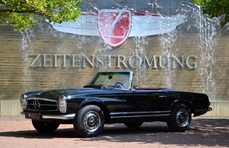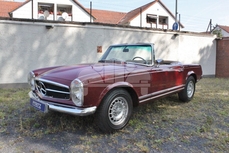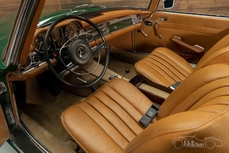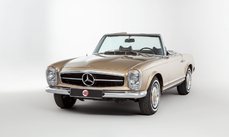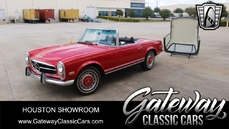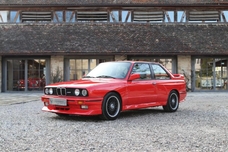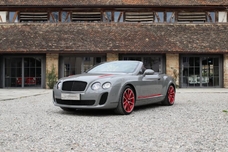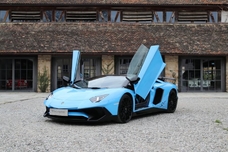Mercedes-Benz 280SL w113 SL Pagode 1969
General description :
Diese wunderschöne Mercedes-Benz 280 SL Pagode wurde am 26. November 1970 in die USA ausgeliefert und 1971 auf seinen ersten Besitzer zugelassen. Aufgrund der sehr guten Substanz wurde die Pagode 2004 nach Deutschland importiert und in den letzten Jahren von einem deutschen Fachbetrieb auf höchsten Niveau vollrestauriert. Nach dem Entlacken der kompletten Karosserie wurde diese im Farbton Anthrazit-Grau neu lackiert und präsentiert sich im schönem Glanz mit tollen Flächen. Sämtliche Anbauteile, der Chrom als auch die Technik mit Motor, Getriebe und Achsen wurden ebenfalls vollständig restauriert und arbeiten vorbildlich. Die neu bezogene Innenausstattung präsentiert sich in wunderschönem cognac-farbenen Echtleder. Sichern Sie sich diese wunderschöne Pagode in toller Farbkombination. Wir liefern das Fahrzeug mit neuem TÜV sowie der begehrten H-Zulassung!
This beautiful Mercedes-Benz 280 SL pagoda was delivered to the USA on November 26, 1970 and delivered to its first owner in 1971. Due to the very good substance, the pagoda was imported to Germany in 2004 and fully restored by a German specialist at the highest level. After the entire body was stripped, it was repainted in anthracite-gray and presented with great surfaces and a beautiful sheen. All attachments, the chrome and the technology with the engine, transmission and axles have also been completely restored and work exemplary. The newly upholstered interior is presented in beautiful cognac-colored real leather. Secure this beautiful pagoda in a great color combination. We deliver the vehicle with a new TÜV and the coveted H approval!
Zwischenverkauf und Irrtümer für dieses Angebot
sind ausdrücklich vorbehalten. Ausschlaggebend sind einzig und allein die Vereinbarungen im Kaufvertrag.
1969 Mercedes-Benz 280SL w113 SL Pagode is listed for sale on ClassicDigest in Polling by HK-Engineering GmbH for €149000.
Car Facts
Car type : Car Make : Mercedes-Benz Model : 280SL w113 Model Version : SL Pagode Engine size : 0.0 Model Year : 1969 Location : Polling Vehicle Registration : Undefined
149000 €
People who viewed this Mercedes-Benz 280SL w113 also viewed similar Mercedes-Benz listed at ClassicDigest
Other cars listed for sale by this dealer
About Mercedes-Benz
In the annals of automotive history, the journey of Mercedes-Benz is a tale that unfolds with the ingenuity of its founding pioneers. In the year 1886, Karl Benz crafted the Benz Patent Motorwagen, a creation that would go down in history as the world's inaugural automobile. Unbeknownst to him, this moment marked the genesis of what would evolve into the most illustrious premium car manufacturer globally. The financial underpinning of this pioneering venture, interestingly, was provided by Karl Benz's wife, Bertha Benz, demonstrating a remarkable partnership that would set the tone for Mercedes-Benz's legacy.A parallel narrative emerged not far away, as Daimler-Motoren-Gesellschaft, founded by Gottlieb Daimler and Wilhelm Maybach, entered the scene. In 1901, they unveiled their automobile under the now-famous moniker "Mercedes," meaning "godsend" in Spanish. This name was bestowed upon the car at the behest of Emil Jellinek's daughter, the distributor for Daimler-Motoren-Gesellschaft. The wheels of innovation were set in motion.
Fast forward to 1926, a pivotal year that witnessed the merger of Daimler with Benz & Cie., culminating in the birth of Daimler-Benz. The amalgamation saw the adoption of "Mercedes-Benz" as the distinguished trademark for their automobiles, fusing the legacies of two visionary entities into one.
Contrary to perceptions of conservatism, the trajectory of Daimler-Benz unfolds as a chronicle of industry firsts. From the introduction of the honeycomb radiator to the float carburetor, and the pioneering implementation of four-wheel brakes in 1924, Daimler-Benz consistently pushed the boundaries of automotive innovation. The diesel-powered Mercedes-Benz 260 D in 1936 marked the inception of diesel engines in passenger cars. The iconic Mercedes-Benz 300SL Gullwing made history as the first car with direct fuel injection, albeit the Gutbrod's tiny 2-stroke engine can claim precedence.
Safety innovations became a hallmark, with Béla Barényi's patented safety cell design in the "Ponton"-models in 1951, featuring front and rear crumple zones. The W116 450SEL 6.9 saw the introduction of the Anti-Lock Brake system (ABS), another pioneering safety feature. From the first production airbags and beyond, the legacy of "firsts" continued to be etched into the fabric of Daimler-Benz.
Over its centennial journey, Mercedes-Benz has not merely produced cars but has sculpted automotive icons. The SSKL, 710 SSK Trossi Roadster, 770K Grosser, 540K Spezial Roadster, 300SL Gullwing, w100 600 Pullman, w111 280SE 3.5 Flachkühler, w113 230SL Pagoda, w109 300 SEL 6.3, and w201 2.3-16 Cosworth stand testament to the brand's commitment to engineering excellence.
The roaring Silver Arrows, or "Silberpfeile," including the W 25, W 125, W154, W165, and W196, created a legacy of dominance on the racetrack. These machines were not merely cars; they were expressions of precision, speed, and an indomitable spirit that left their competitors in the dust.
As Mercedes-Benz marches into the future, it does so not just as an automaker but as a custodian of a legacy, a torchbearer of innovation, and a beacon of automotive excellence. The road ahead is sure to witness the continued fusion of cutting-edge technology, timeless design, and an unwavering commitment to setting new standards in the world of automobiles.
One luminary figure who left an indelible mark was Béla Barényi, often heralded as the "father of passive safety" for his pioneering work in safety engineering. His patented safety cell design, featuring front and rear crumple zones, became a hallmark of Mercedes-Benz's commitment to occupant safety, setting new standards that reverberated throughout the automotive world.
Moving through the chronicles, the collaborative genius of Wilhelm Maybach, alongside Gottlieb Daimler, laid the foundation for Daimler-Motoren-Gesellschaft. Their innovations not only birthed the first Mercedes but established a culture of relentless pursuit of technological excellence that remains integral to Mercedes-Benz's DNA.
In the post-merger era of 1926, Ferdinand Porsche emerged as a prominent figure within Mercedes-Benz. His work on the Mercedes-Benz S-Type, a supercharged race car, garnered acclaim and set the stage for a legacy that extended far beyond the marque. Porsche's impact would later extend to his eponymous company, but his influence at Mercedes-Benz during those formative years was pivotal.
As the 20th century progressed, the legendary Rudolf Uhlenhaut emerged as a key figure. Uhlenhaut, an accomplished engineer and the driving force behind the iconic Silver Arrows, played a crucial role in Mercedes-Benz's dominance in motorsports. His engineering prowess and attention to detail were instrumental in creating some of the most formidable racing cars of the era.
In the latter half of the century, figures like Bruno Sacco, the head of design at Mercedes-Benz from 1975 to 1999, left an indelible imprint on the brand's aesthetic identity. Sacco's design philosophy, characterized by clean lines and timeless elegance, shaped iconic models like the W126 S-Class and the W201 190E, solidifying Mercedes-Benz's reputation for luxury and sophistication.
The narrative would be incomplete without acknowledging the contributions of engineers like Hans Scherenberg, whose leadership in the 1970s ushered in a new era of technological innovation at Mercedes-Benz. Scherenberg's tenure saw the development of groundbreaking technologies, including the Anti-Lock Brake system (ABS) and the introduction of airbags in production cars.
















